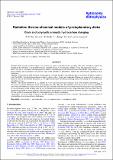Files in this item
Radiation thermo-chemical models of protoplanetary disks : grain and polycyclic aromatic hydrocarbon charging
Item metadata
| dc.contributor.author | Thi, W. F. | |
| dc.contributor.author | Lesur, G. | |
| dc.contributor.author | Woitke, P. | |
| dc.contributor.author | Kamp, I. | |
| dc.contributor.author | Rab, Ch | |
| dc.contributor.author | Carmona, A. | |
| dc.date.accessioned | 2019-10-04T15:30:01Z | |
| dc.date.available | 2019-10-04T15:30:01Z | |
| dc.date.issued | 2019-12 | |
| dc.identifier | 258237933 | |
| dc.identifier | b3bebe2b-81d0-4543-8780-6f56d31bdf55 | |
| dc.identifier | 000503815200001 | |
| dc.identifier | 85102646222 | |
| dc.identifier.citation | Thi , W F , Lesur , G , Woitke , P , Kamp , I , Rab , C & Carmona , A 2019 , ' Radiation thermo-chemical models of protoplanetary disks : grain and polycyclic aromatic hydrocarbon charging ' , Astronomy & Astrophysics , vol. 632 , A44 , pp. 1-28 . https://doi.org/10.1051/0004-6361/201732187 | en |
| dc.identifier.issn | 0004-6361 | |
| dc.identifier.other | ArXiv: http://arxiv.org/abs/1811.08663v1 | |
| dc.identifier.uri | https://hdl.handle.net/10023/18613 | |
| dc.description | Funding: EU FP7-2011 under Grant Agreement no. 284405 (I.K., W.F.T., and P.W). | en |
| dc.description.abstract | Context. Disks around pre-main-sequence stars evolve over time by turbulent viscous spreading. The main contender to explain the strength of the turbulence is the magnetorotational instability model, whose efficiency depends on the disk ionization fraction. Aims. Our aim is to compute self-consistently the chemistry including polycyclic aromatic hydrocarbon (PAH) charge chemistry, the grain charging, and an estimate of an effective value of the turbulence α parameter in order to find observational signatures of disk turbulence. Methods. We introduced PAH and grain charging physics and their interplay with other gas-phase reactions in the physico-chemical code PRODIMO. Non-ideal magnetohydrodynamics effects such as ohmic and ambipolar diffusion are parametrized to derive an effective value for the turbulent parameter αeff. We explored the effects of turbulence heating and line broadening on CO isotopologue submillimeter lines. Results. The spatial distribution of αeff depends on various unconstrained disk parameters such as the magnetic parameter βmag or the cosmic ray density distribution inside the protoplanetary disk s. The inner disk midplane shows the presence of the so-called dead zone where the turbulence is almost inexistent. The disk is heated mostly by thermal accommodation on dust grains in the dead zone, by viscous heating outside the dead zone up to a few hundred astronomical units, and by chemical heating in the outer disk. The CO rotational lines probe the warm molecular disk layers where the turbulence is at its maximum. However, the effect of turbulence on the CO line profiles is minimal and difficult to distinguish from the thermal broadening. Conclusions. Viscous heating of the gas in the disk midplane outside the dead zone is efficient. The determination of α from CO rotational line observations alone is challenging. | |
| dc.format.extent | 28 | |
| dc.format.extent | 5449203 | |
| dc.language.iso | eng | |
| dc.relation.ispartof | Astronomy & Astrophysics | en |
| dc.subject | Astrochemistry | en |
| dc.subject | Molecular data | en |
| dc.subject | Stars: pre-main-sequence | en |
| dc.subject | Protoplanetary disks | en |
| dc.subject | QB Astronomy | en |
| dc.subject | QC Physics | en |
| dc.subject | NDAS | en |
| dc.subject.lcc | QB | en |
| dc.subject.lcc | QC | en |
| dc.title | Radiation thermo-chemical models of protoplanetary disks : grain and polycyclic aromatic hydrocarbon charging | en |
| dc.type | Journal article | en |
| dc.contributor.sponsor | European Commission | en |
| dc.contributor.sponsor | European Commission | en |
| dc.contributor.institution | University of St Andrews. School of Physics and Astronomy | en |
| dc.contributor.institution | University of St Andrews. St Andrews Centre for Exoplanet Science | en |
| dc.identifier.doi | 10.1051/0004-6361/201732187 | |
| dc.description.status | Peer reviewed | en |
| dc.identifier.url | https://arxiv.org/abs/1811.08663 | en |
| dc.identifier.grantnumber | 284405 | en |
| dc.identifier.grantnumber | en |
This item appears in the following Collection(s)
Items in the St Andrews Research Repository are protected by copyright, with all rights reserved, unless otherwise indicated.

